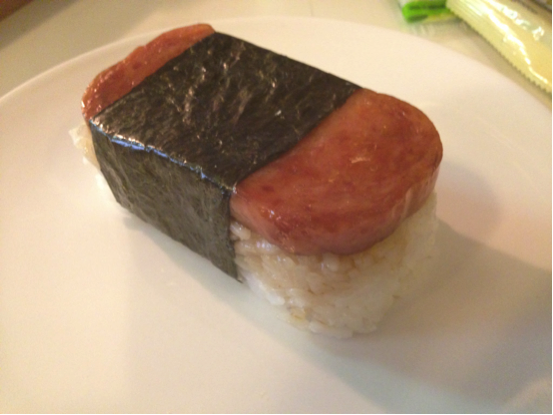Foods of War: Spam
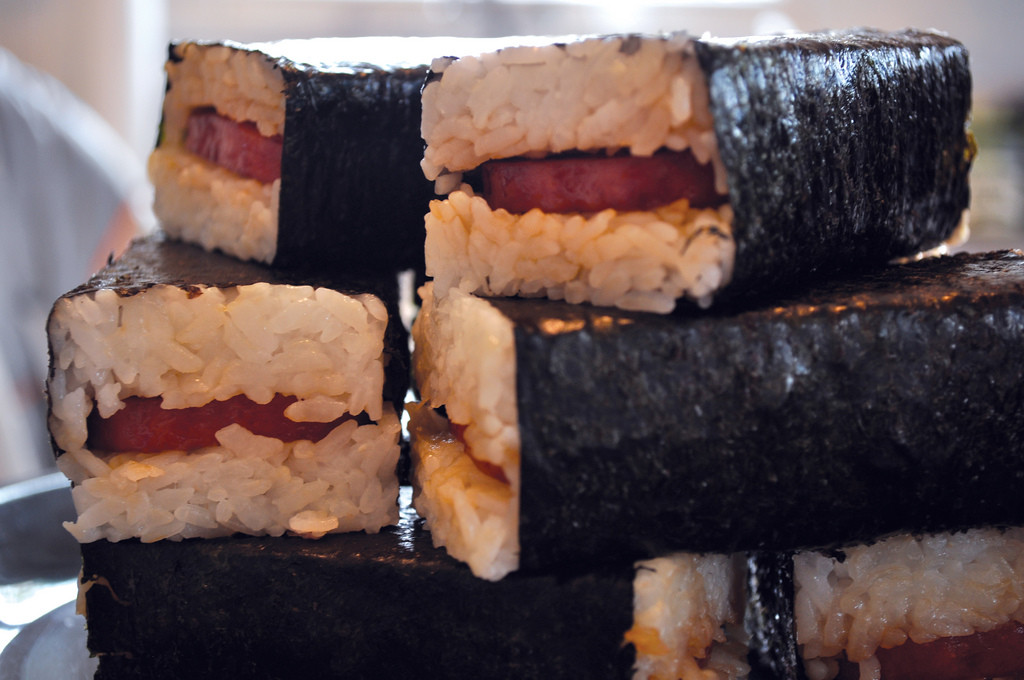
Editor’s note: This is the third piece in our series “Foods of War.” The intention is to examine the historicity behind different rations and meals served to soldiers and sailors over the years, and see if their reputations are deserved. Finally, since it wouldn’t be a Molotov Cocktail article without some element of drinking, we’ll incorporate a drink pairing, principally so that we’ve got something to wash it all down. Keep an eye out for future posts, and cheers!
No discussion of the foods of war would be complete without exploring the tinned meat that America loves to hate. Yes, dear readers, I’m speaking of the shelf-stable, metal-ensconced protein: Spam.
Spam was launched in 1937 by Hormel Foods and marketed as a way for Great Depression-era families to put meat on the table. Because of its packaging, shelf-stability, and cost, Spam (along with other canned meats) was purchased in massive quantities by the U.S. government. In fact, by the end of World War II, the U.S. Army had purchased 150 million pounds of Spam.
Spam wasn’t just consumed by U.S. forces though. Through the Lend-Lease Act, Spam became a truly global commodity, and was soon feeding Great Britain and the USSR during and after the war. Margaret Thatcher called Spam a “war time delicacy,” and Nikita Khrushchev said that without Spam, the Soviet Union would have been unable to feed its army.
American GIs developed a love-hate relationship with Spam. One South Pacific Army Air Force encampment was jokingly dubbed Spamville by its men, and Uncle Sam became known as … well you can probably guess. Ultimately, after eating Spam for three “squares” a day, many service members began to tire of the potted meat. Soldiers would write to Hormel to express their distaste with the food. Hormel President Jay Hormel kept a file of these letters and was quoted as saying “If they think Spam is terrible they ought to have eaten the bully beef we had in the last war” (a reference to the corned beef consumed by soldiers in World War I).
The war ultimately ended, but Spam persevered. Since its emergence on the battlefield, Spam has developed a place as both a staple and cult favorite across the world. While it is no longer found on British or Russian tables, it has particularly taken hold in the South Pacific. The average Guamanian consumes 16 cans of the stuff each year and it is an important part of contemporary Hawaiian cuisine. Post-war Hawaii continued to have a large U.S. military presence and getting fresh meat to these troops remained challenging. This, in combination with the large Japanese, Filipino, and Chinese migrant population led to the development of fusion cuisines employing traditional Asian preparation methods with American influence and Spam as the primary protein. This is illustrated perfectly by the Spam musubi, a play on the traditional Japanese onigiri, but with Spam taking center stage, complemented by sushi rice and nori (seaweed).
Unlike previous recipes in this series, World War II GIs certainly weren’t eating Spam musubi while downrange, but it is a dish that illustrates how culinary traditions are created, transformed, and embraced through conflict and migration.
Recipe (makes 8 pieces)
2 Cups sushi rice (short or medium grain)
1 1/2 Cups cold water
4 Tbsp rice wine vinegar
3 Tbsp sugar
1 Tsp salt
2 Sheets nori
1 Tin Spam
1/4 Cups soy sauce
1/4 Cups sugar
1/2 Tbsp fish sauce
The most complicated part of this recipe is making the rice. Sushi chefs train for years to properly make rice, and the method described below definitely isn’t going to yield Jiro-level rice. However, it’ll be good enough for Spam musubi.
First, rinse your rice. This washes excess starch from the grain so that it won’t be a mushy mess at the end. Put the rice in a large sieve and gently rub the grains between your hands while rinsing under cold water. When the water coming out the bottom is clear, you’re good to go.
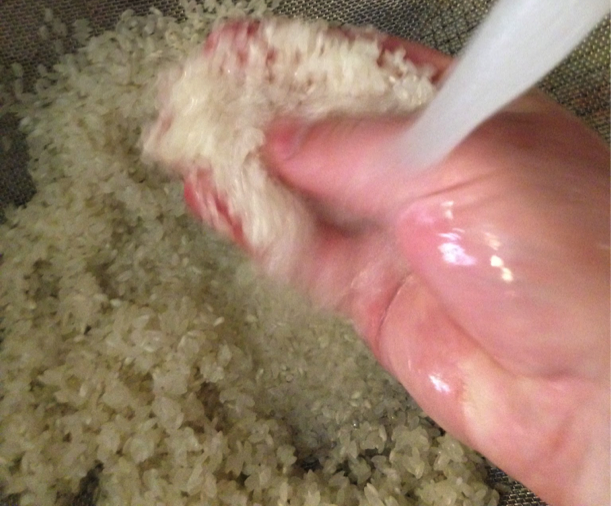 Next put your rice in the pot and cover with 1 1/2 cups of cold water. Let it sit for 30 minutes.
Next put your rice in the pot and cover with 1 1/2 cups of cold water. Let it sit for 30 minutes.
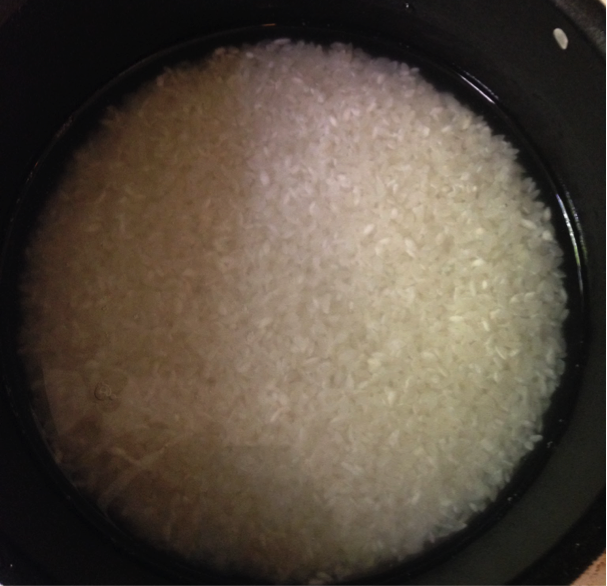 After the rice has absorbed some of the cold water, turn the heat up to high and, once at a boil, bring down to low and cook, covered, for 15 minutes. After 15 minutes have passed, cut the heat and allow it to sit and steam for 10 minutes.
After the rice has absorbed some of the cold water, turn the heat up to high and, once at a boil, bring down to low and cook, covered, for 15 minutes. After 15 minutes have passed, cut the heat and allow it to sit and steam for 10 minutes.
While waiting, combine the vinegar, 3 tablespoons of sugar, and salt. Microwave the vinegar to heat it up if the sugar and salt aren’t completely dissolved.
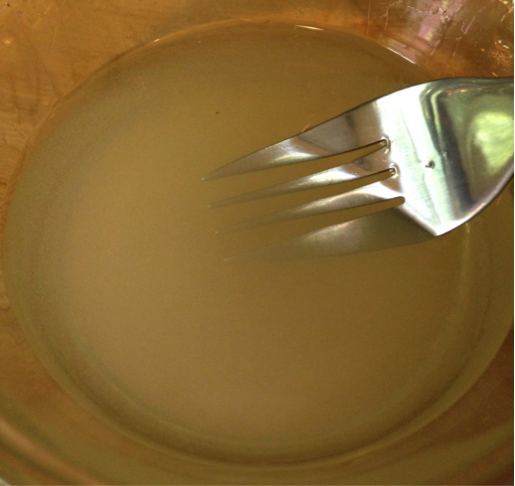 Pour the hot rice into a large bowl (to maximize surface area). Next, pour over the vinegar dressing and begin to gently cut it in (using a wooden spoon make horizontal and vertical cuts in the rice). Do this with one hand while fanning with a piece of cardboard in the other.
Pour the hot rice into a large bowl (to maximize surface area). Next, pour over the vinegar dressing and begin to gently cut it in (using a wooden spoon make horizontal and vertical cuts in the rice). Do this with one hand while fanning with a piece of cardboard in the other.
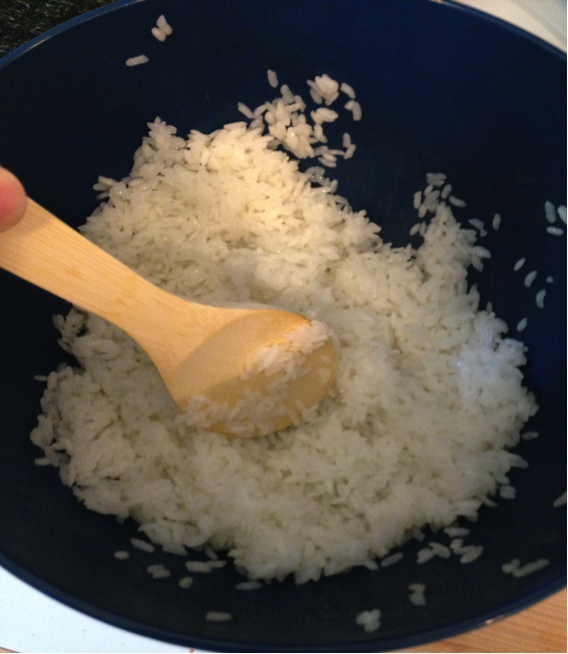 You want to simultaneously coat the rice in the dressing while cooling it and evaporating excess moisture. When your rice has cooled to warm, you can cover it with a wet towel and set it aside.
You want to simultaneously coat the rice in the dressing while cooling it and evaporating excess moisture. When your rice has cooled to warm, you can cover it with a wet towel and set it aside.
To prepare the Spam, open the tin and cut it into eight slices.
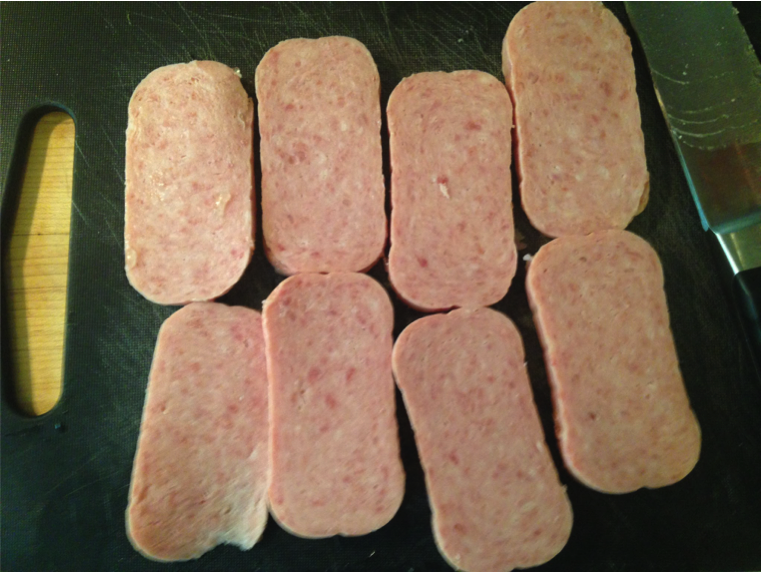 Set a heavy-bottomed pan over medium heat, and sear the Spam on both sides.
Set a heavy-bottomed pan over medium heat, and sear the Spam on both sides.
 While the Spam is searing, combined 1/4 cup of soy sauce with 1/4 cup of sugar and 1/2 tablespoon of fish sauce. Once the Spam has seared, pour the glaze over the meat and let it cook down and caramelize for 5–10 minutes. While waiting, cut your nori sheet into four vertical strips.
While the Spam is searing, combined 1/4 cup of soy sauce with 1/4 cup of sugar and 1/2 tablespoon of fish sauce. Once the Spam has seared, pour the glaze over the meat and let it cook down and caramelize for 5–10 minutes. While waiting, cut your nori sheet into four vertical strips.
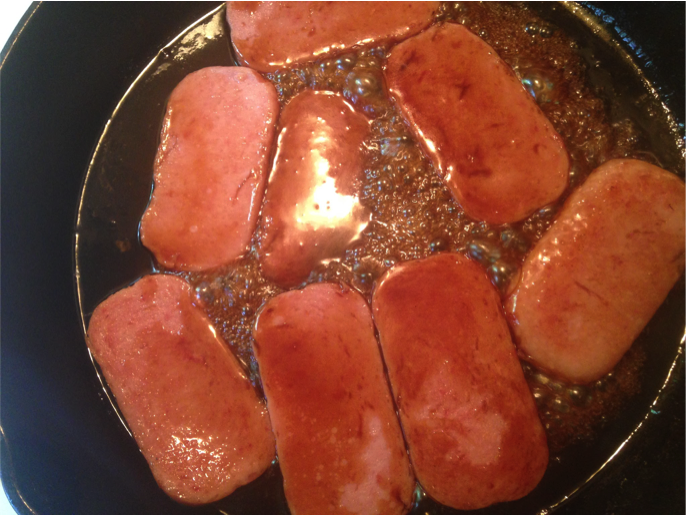 To assemble the musubi, take a rice press (real or improvised from a Spam tin, as shown below) and pack with about 1/2 cup of rice. Apply even pressure so that the rice takes the form of the press.
To assemble the musubi, take a rice press (real or improvised from a Spam tin, as shown below) and pack with about 1/2 cup of rice. Apply even pressure so that the rice takes the form of the press.
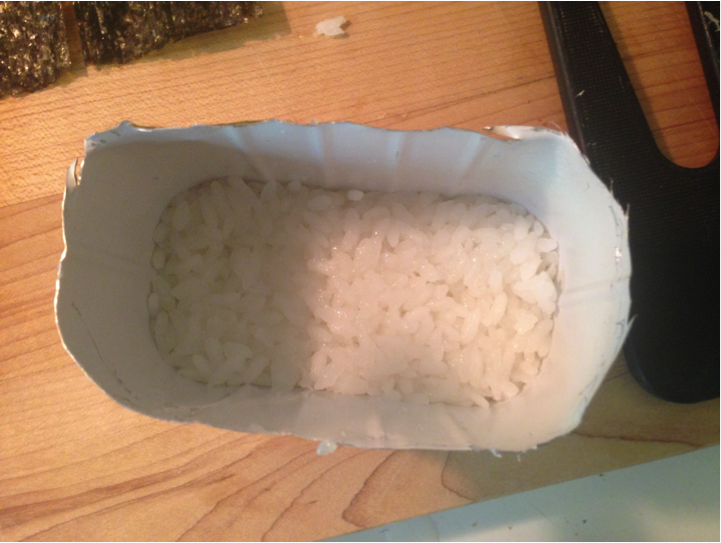 Next, add a slice of Spam and apply pressure again so that the meat adheres to the rice.
Next, add a slice of Spam and apply pressure again so that the meat adheres to the rice.
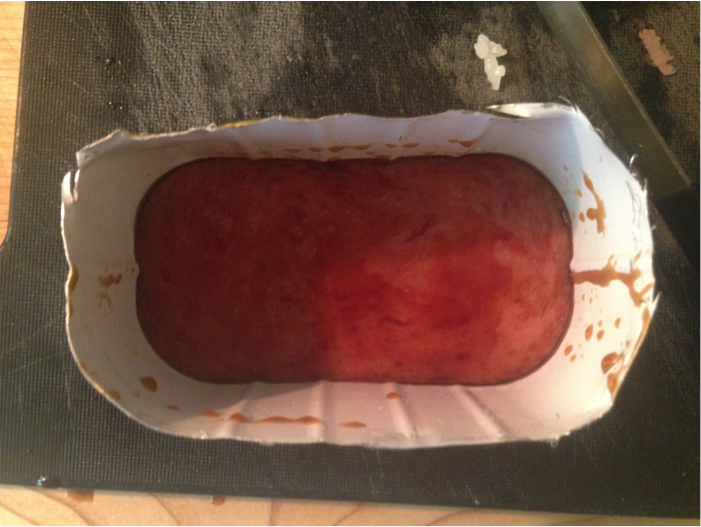 Gently remove the newly formed block from the press.
Gently remove the newly formed block from the press.
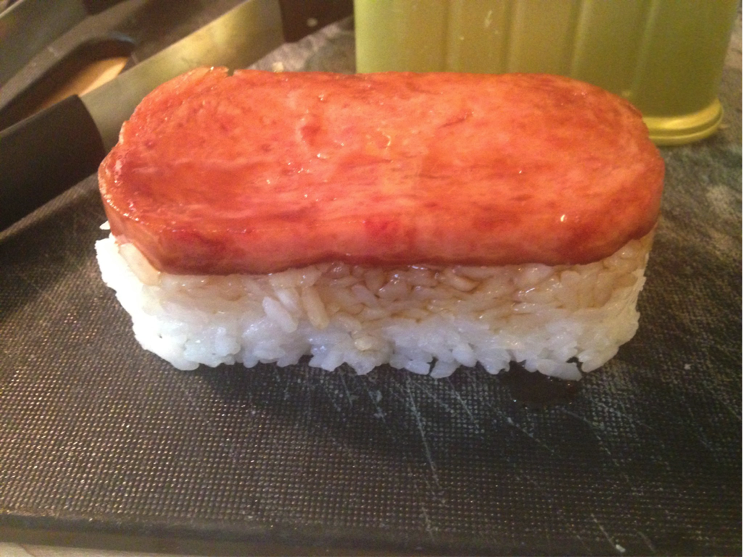 Carefully place it at the edge of a nori strip. Roll the nori around the Spam and rice.
Carefully place it at the edge of a nori strip. Roll the nori around the Spam and rice.
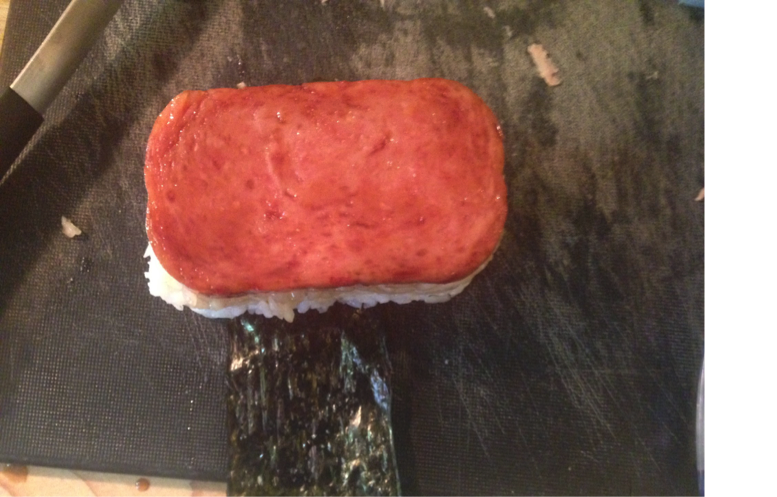 The nori won’t stick right away but will quickly adhere if left to sit for about 30 seconds. Eat immediately or wrap in cling film and refrigerate.
The nori won’t stick right away but will quickly adhere if left to sit for about 30 seconds. Eat immediately or wrap in cling film and refrigerate.
Full disclosure, I really like Spam and think it gets a bad rap, so I was a bit biased going into this. However with that said, this dish is great. Well-cooked and seasoned rice, a salty-sweet porky filling, and subtle flavor of the sea from the nori, create a rich and flavorful morsel. These bites are deceptively filling and rather rich, so it needs something that can cut through the fatty/starchy goodness of the pork and rice. With that in mind, I’d recommend a flavorful lager such as Kona Brewing Company’s Longboard Island Lager. Despite being partially owned by Anheuser Busch, this lager is a refreshing choice for warm weather without sacrificing good hop flavor and body. It’s great for washing down salty foods (which Spam musubi certainly is) and is from Hawaii to boot!
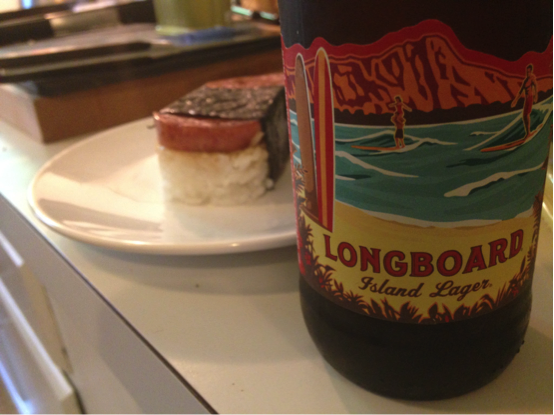 So next time you’re at the market, take a swing through the canned foods section and consider buying a can of Spam to give it the proper Hawaiian treatment. Even if the whole canned meat thing isn’t in your wheelhouse, at least you can pay homage to the food that helped the Allies defeat the forces of fascism and establish the world order we enjoy today.
So next time you’re at the market, take a swing through the canned foods section and consider buying a can of Spam to give it the proper Hawaiian treatment. Even if the whole canned meat thing isn’t in your wheelhouse, at least you can pay homage to the food that helped the Allies defeat the forces of fascism and establish the world order we enjoy today.
James Sheehan is a homebrewer and cider-maker. When he’s not fermenting things he works for a Washington, D.C. based democracy education non-profit. He holds an MA in Terrorism, Security, and Society from King’s College, London.
Photo credit: Kim Love


